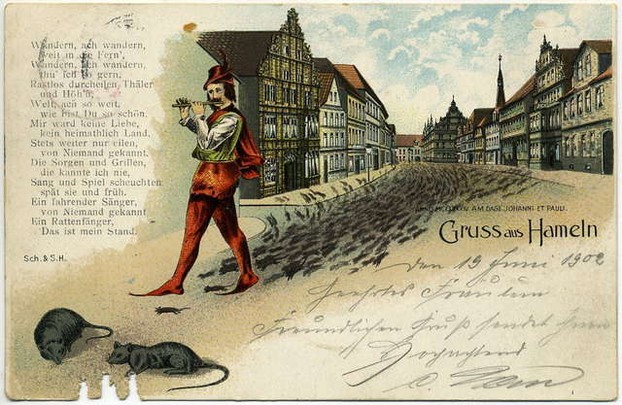The Pied Piper of Hamelin is not a classic fairy tale. The ominous feel of the story is not the only reason for that. Thanks to several documented events with many elements similar to the ones in the story, it is very likely at least partially based on true events. While nobody knows what really happened in the German town of Hamelin in 1284, we can provide several interesting facts which might help to explain the background of this legend.
Here are top ten facts about the Pied Piper of Hamelin.











 Vintage Postcard Artists with 10 Examples of Easter Cardson 02/21/2025
Vintage Postcard Artists with 10 Examples of Easter Cardson 02/21/2025
 Valentine's Symbolson 01/23/2025
Valentine's Symbolson 01/23/2025
 Thanksgiving Symbolson 11/12/2024
Thanksgiving Symbolson 11/12/2024
 Famous Witches in Literary Historyon 10/06/2024
Famous Witches in Literary Historyon 10/06/2024



What do you think about The Pied Piper of Hamelin?
There is a memorial plate in Hamelin (centuries old) stating that many children were lost but there are no specifics about who, why, and how. The legend is unclear.
The Pied Piper of Hamelin always scared, unsettled and worried me.
Would there be a family story or a memorial somewhere to tell us the names of those children who slipped between history's fingers?
Yes, sandyspider, this story makes Hamelin a really interesting tourist spot and city is using it to its full advantage. I believe most of the cities hide similar, althoughj not always so horrifying stories behind their walls. Thanks for stopping by!
I would like to visit Hamelin and see the rat paintings in the pavement. Interesting to this could be part of real events.
Thank you, Veronica, for your comment. I agree with you - there must be true event (or events) behind this story, which after some time and retellings started to live the life of its own.
Thanks, sheilamarie, for stopping by. I think all stories are based on true events. It's only the perspective and imaginary power of the teller which makes a difference between the truth and the fiction.
Excellent. I have been fascinated by this legend for many years. It has always held my attention. I always consider a legend differs from a myth in that a legend may possibly be true.
I always think there is a grain of truth in every tale such as this and your analysis is very thorough.
The idea that it was able bodied youngsters attracted by a musician holds sway with me as a form of recruitment.
Thank you for posting this; I am fascinated all over again.
I didn't realize this story was based on real events. What a tragedy!
The pleasure was all mine, Thamisgith:)
Thanks for an interesting and enjoyable read Tolovaj.